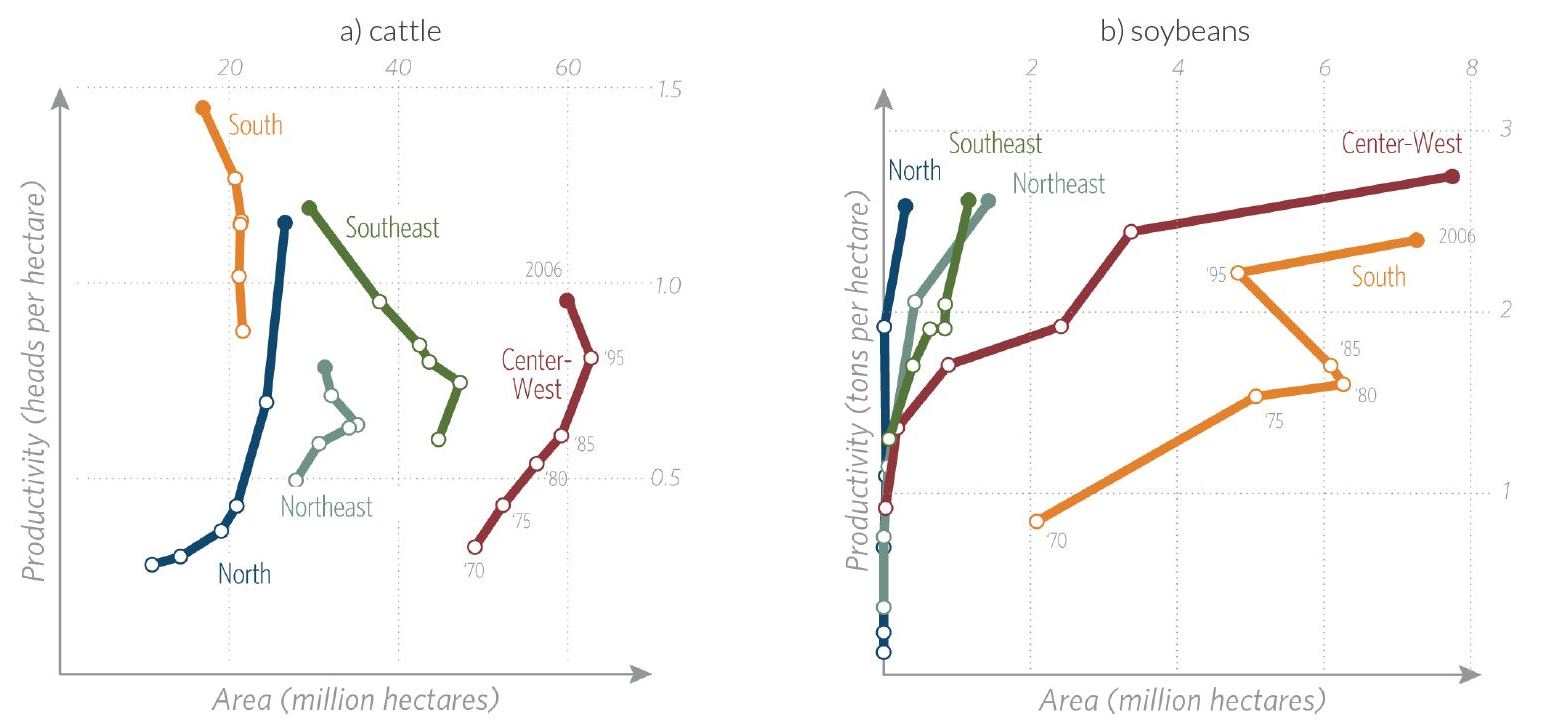As the demand for food and climate change risk both increase, a new study explores paths to more efficient land use in the country.
As Brazilian President Dilma Rousseff promised to reduce Brazil’s greenhouse gas emissions by 43 per cent by 2030. Brazil became the first major developing country to pledge an absolute reduction in emissions over the next fifteen years. Since the country is an agricultural leader with abundant natural resources, it clearly has many challenges ahead. One of the questions that arises is whether it is possible to simultaneously promote economic growth and improve ecosystem protection within Brazil’s rural landscape.
Indeed, past experience shows that it is feasible to change land use patterns at scale in a way that achieves both natural protection and economic development. The process, nevertheless, can be accelerated. This is the key message of a new study recently launched by Climate Policy Initiative Brazil (CPI).
Since the colonial period, the occupation of the Brazilian territory was based on a vision that land was an abundant resource. Policies were formed around this vision, which had negative implications for efficiency of agricultural production and for protection of natural assets. Today, however, this represents an opportunity.
Our research shows that only one third of the variation in productivity is explained by geographical characteristics. Our evidence suggests that it is possible to increase agricultural production through better resource allocation, at no cost to environment preservation.
LESSONS FROM THE PAST
Brazil is already in a process of addressing the inefficiency in land use. The following examples illustrate that technological innovation and dissemination, private investment and more effective policies are valuable tools to promote a shift in land use patterns at scale.
First, we see that the combination of technological adoption and skilled migration, during the Brazilian soybean revolution in the 1970s and 1980s, led farmers to invest in agricultural intensification, reducing total land use. This technological shift reshaped agriculture in Central Brazil and integrated it with international markets. As a consequence of this process, there was an increase in agricultural production while the rate in which forests were cleared decreased.
Second, the entry of sugarcane mills promoted important changes in the state of Mato Grosso do Sul in the 2000s. Due to substantial private investments, land use moved from low productivity pastures to high productivity crops, with no impact on native vegetation. We found that GDP in a typical municipality increased significantly after the installation of the plants.
Evolution of Productivity and Area for Cattle and Soybean, 1970-2006

Third, the adoption of several strategic conservation measures, with emphasis on monitoring and law enforcement, led to a drastic reduction of deforestation in the Brazilian Amazon. Between 2004 and 2012, the deforestation rate decreased from 2.7 million hectares to 460 thousand hectares. Importantly, there was no impact on agricultural production, which indicates misallocation of land resources.
Looking ahead
Delivering efficient land use can be achieved through a wide range of mechanisms. In our study, we look at ways to improve economic and environmental returns from land use.
The improvement of technology dissemination is a key mechanism in this process. Increasing agricultural productivity by spreading information on new techniques is essential. A good example in Brazil is the spread of a no-till farming method, known as Direct Planting System (DPS). The diffusion and adoption of DPS happened through a process of learning from peers who had already adopted this new technology.
Another useful strategy to improve land use efficiency consists of deregulating land rental markets, as this can attract more skilled operators on unused or unproductive available land. Today, rental markets in Brazil are much smaller than in other countries and the legislation on the subject is outdated.
A well-functioning financial system also plays a central role in driving efficient land use. For instance, rural producers can contribute to improving productivity if they have greater access to credit. Interestingly, we found that agricultural productivity varies about 20 percent among regions in Brazil due to credit availability. Furthermore, market-based instruments need to be developed to help farmers better deal with uncertainty and risk. Today, the government is limited to buying out farmers’ output so that they can guarantee a minimum price.
Finally, using public policy to improve the quality of infrastructure in Brazil is fundamental in helping to boost agricultural productivity by facilitating how goods get to broader markets. One key example is that inadequate road infrastructure fails to efficiently connect products with ports. Smarter public-private regulations could pave the way for better productivity, but the general trend in the country has been to prevent existing infrastructure concessionaires from making long-term profits from their investments.
In addition to applying these mechanisms to improve agricultural productivity, Brazil needs effective conservation policies. In this regard, our study identifies several challenges. Creating better systems for dealing with small-scale deforestation and strengthening monitoring and law enforcement in forest areas outside the Amazon are some of the key ones. Also, improving enforcement of environmental regulation within private rural properties is essential. In this respect, the Brazilian Forest Code, enacted in 2012, establishes the regulatory framework for environmental conservation in private lands, by imposing land use limitations. However, effectively implementing the Forest Code remains a challenge.
In sum, such measures provide an opportunity to address climate change risk and increase food production, while protecting natural resources, in an overall strategy for developing Brazil’s rural economy more effectively. As an agricultural power and with abundant natural resources available, Brazil is a key player in this space and can lead the way toward a low-carbon agriculture.
This blog post originally appeared on the Green Growth Knowledge Platform.

